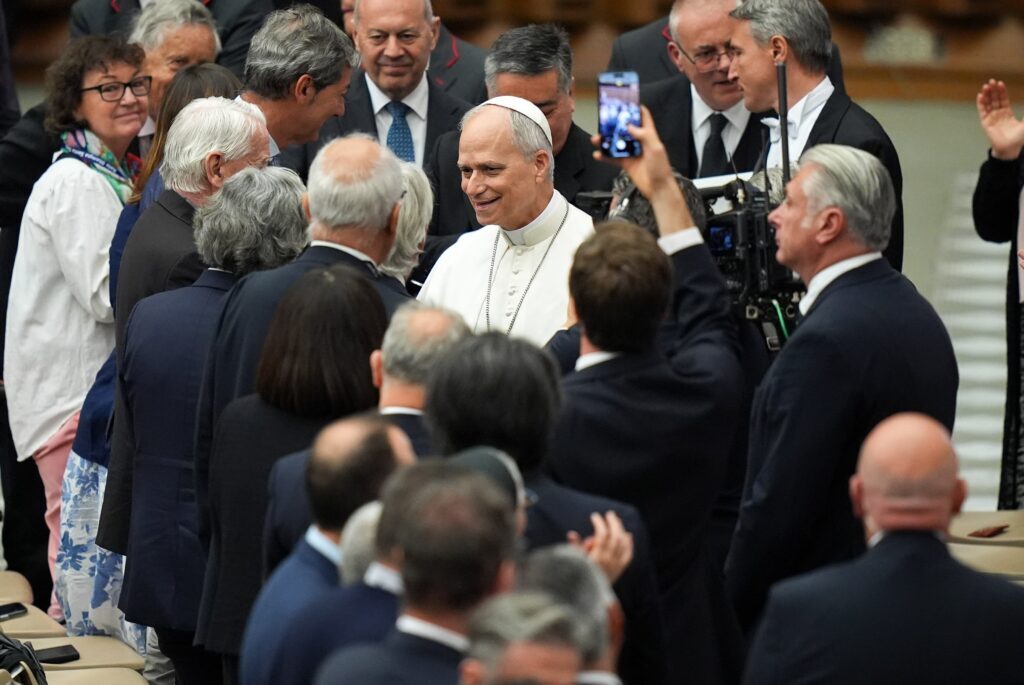PHOENIX (OSV News) — Catholic media play a vital role in bearing truth and witnessing to the Gospel, especially amid the digital age and a crucial moment for the church, said experts during a panel discussion at the 2025 Catholic Media Conference.
As part of the conference, which this year took place June 24-27 in Phoenix, Catholic media professionals participated in a June 26 panel discussion on “Catholic Media as Bearers of Truth: Evangelization, Integrity and the Digital Age.”
Panelists included Gretchen R. Crowe, editor-in-chief of OSV News; James Rogers, chief communications officer of the U.S. Conference of Catholic Bishops; and Edmundo Reyes, co-founder of the media production and creative agencies Digital Continent and Real+True, along with the ministry formation platform Revive Parishes.
The discussion was moderated by Jeanette De Melo, strategic initiatives director for EWTN News.
How Catholic Communicators Can Spread Gospel
De Melo noted at the outset that Pope Leo XIV has already given a “clear chart” on how Catholic communicators can spread the Gospel while maintaining journalistic integrity.
She quoted the pope’s May 12 address to representatives of the media, in which he urged media professionals to “strive for a different kind of communication” that ultimately fosters peace by eschewing aggressiveness, competition, compromise and consensus at all costs.
Crowe — who had attended Pope Leo’s address amid OSV News’ coverage of the papal transition — said that mandate for Catholic media to be peacemakers was a recognition “that what we do as communicators, as Catholic communicators, isn’t what any communicator does … it’s a vocation.”
“It means we believe strongly that what we are doing is in service to the church. And through our work, we are bringing people to Christ,” said Crowe. “And when you do the work of the church, when you live out this vocation well, you are bearing the fruits of the Holy Spirit. And one of those, of course, is peace. And thanks be to God, because we need peace in our world right now.”

Gratitude is another “recurring theme” in Pope Leo’s pontificate, said Reyes.
He added that the current conversation about the church is focusing less on the past, and more on possibilities for the future.
While “we still have an abuse crisis” involving the church in several nations, he said, many are now “listening to and watching” the church with a “fierce curiosity and openness that I don’t think we’ve had in many, many, many years.”
As a result, said Reyes, Catholic communicators have an “opportunity to reintroduce the church in this new environment.”
A True ‘Kairos Moment’
Rogers described the present as a true “kairos moment,” using the Greek term for a decisive point in time that allows for essential action.
“Prior to this moment … we measured our audience in the thousands, sometimes in the tens of thousands,” said Rogers. “Ever since the election (of Pope Leo), we’ve been measuring our audience in the millions.”
However, he cautioned, “we’re not going to have that audience forever,” and so it is all the more urgent to “put a compelling invitation on the table” that allows curiosity to develop “into a relationship with Jesus.
“We’re trying to build the kingdom of God on earth,” said Rogers.
Among the challenges facing Catholic communicators is artificial intelligence, identified by Pope Leo as a crucial issue to be addressed through the lens of the faith in order to safeguard human dignity.
Social Media Analysis
Citing data from a recent social media analysis commissioned by the USCCB, Rogers cautioned that AI and malign actors can profoundly skew engagement with the church’s message online, with fake users and divisive posts.
“Make sure you are influencing social media rather than being influenced by social media,” he said.
Crowe pointed to a June 26 CMC conference presentation on AI by award-winning investigative journalist Mark Greenblatt, a professor of practice at Arizona State University’s Walter Cronkite School of Journalism and Mass Communication.
She emphasized Greenblatt’s call for “healthy paranoia” about social media content, which can include startlingly realistic videos, still images and audio recordings completely generated by AI.
AI and Need for Reporting Diligence
“We have to make sure that the sources that we’re using, the stories, the leads that we’re following … are accurate and that we’re able to form reports (based) on reality,” Crowe said, noting that the audience’s trust of Catholic media depends on such diligence.
“Trust is digital currency,” Reyes added.
He also provided practical examples of how AI benefits his creative process, from script writing to the logistics of filming.
Crowe stressed the “need to listen and learn from one another until we can find the best way forward.”
Rogers said his team employs AI for “macro analysis” of social media, particularly to identify influencers beyond traditional media to enable the nation’s Catholic bishops to engage in such conversations.
‘Next Generation of Catholic Journalists’
All of the panelists observed that Catholic communicators need to nurture what De Melo described as “the next generation of Catholic journalists.”
Rogers repeated a phrase that emerged during a meeting Pope Francis held in early 2025 with bishops’ conference communicators — a call to “co-produce with young people.
“And the idea was not simply creating content that we hope young people will consume, but if we really want to be heard in the world today, we need to be creating that content with them,” said Rogers.
Gina Christian is a multimedia reporter for OSV News. Follow her on X @GinaJesseReina.




